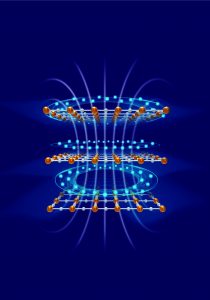News
UNVEILING THE MYSTERIES OF QUANTUM MATERIALS WITH THE MOST POWERFUL MAGNETIC FIELDS
Predicting and observing new phenomena, and unveiling new properties of materials are among the greatest challenges facing physics. These challenges are also at the heart of the “ultra-quantum matter” project, one of the Institut quantique’s four promising projects, in which Prof. Louis Taillefer is involved. The article Electrons with Planckian scattering obey standard orbital motion in a magnetic field, the work of PhD student Amirreza Ataei and CNRS research director Cyril Proust in France, deepens our understanding of electron motion in so-called “strange metal” materials such as superconducting cuprates.
Electrons interact in these materials at a rate that appears to be dictated by Planck’s constant, suggesting that a new fundamental law of quantum physics is at stake. What is observed in the laboratory is a linear dependence of electrical resistivity on temperature – whereas standard theory predicts a quadratic dependence. In a previous publication, scientists in Prof. Taillefer’s group showed that the collision time between electrons is indeed “Planckian” – a discovery that was chosen by Québec Science as one of the 10 discoveries of the year 2021.
In the present publication, the team of scientists explore how electron dynamics in strange metals are affected by a magnetic field. To answer this question, resistivity must be measured as a function of magnetic field.
Bringing together expertise
The success of such measurements depends first and foremost on the quality of the samples used. The materials chosen were high-temperature superconducting cuprates based on lanthanum and strontium – Nd0.4La1.6-xSrxCuO4 and La2-xSrxCuO4. These quantum materials, for this highly collaborative research project, were synthesized in the research laboratories of colleagues in the USA, Japan and Germany.
In addition to collaborating with three experienced research groups who synthesized the single crystals, Amirreza Ataei drew on the expertise of colleagues in France. “We need to apply the highest possible magnetic fields to really test the interactions of the electrons. This is where the collaboration with Cyril Proust of the LNCMI (Laboratoire national des champs magnétiques intenses) in Toulouse, France, makes sense. In this laboratory, we can subject our samples to fields of up to 85 teslas, one of the most intense in the world”. This Sherbrooke-France collaboration is part of the activities of the Laboratoire Frontières Quantiques, a CNRS International Research Lab (IRL) based in Sherbrooke.
Measurements and simulations

Amirreza offers a few explanations: “In our measurements, we applied the magnetic field in various ways, either perpendicular to the direction of the current, or parallel to the direction of the current. We have found that magnetoresistance can be calculated and quantitatively simulated based on current solid theory and parameters taken from previous measurements on similar samples. If one sentence were to sum up the paper, it would be the fact that the electron collision time does not depend on the magnetic field applied in these materials – whereas it does depend very strongly on temperature, in a way that is still not understood and which fascinates scientists.”
Choosing Sherbrooke
The opportunity to access a network of researchers and a wide range of expertise is what motivated Amirreza to choose the Université de Sherbrooke after his undergraduate studies at the Isfahan University of Technology in Iran.
“I was attracted by the combination of specialists in quantum materials, quantum information, and quantum engineering. In the field of quantum materials, in particular, we have world-class researchers in Sherbrooke on both the theoretical and experimental sides, with state-of-the-art laboratories and facilities. This makes the Institut quantique a unique place.”
The student in Prof. Taillefer’s group has the chance to design and develop different measurement techniques under extreme conditions, and to make various academic collaborations that can collectively advance understanding of the various mysterious phases of quantum materials.
Diversified career
Amirreza is exploring entrepreneurship and making the most of his experience. “In 2021, I founded Chemia Discovery Inc, a company for the exploration of advanced materials, including quantum materials.” With an interdisciplinary team of 8 other Université de Sherbrooke students in addition to Amirreza, Chemia is developing a smart, integrated network of microfurnaces and microanalyzers to accelerate materials discovery with unprecedented speed. They recently successfully completed the prototyping of a microfurnace and are currently carrying out functional tests. “The opportunity to improve the search for new materials motivated me to work on the startup in parallel with my PhD.”
“At Chemia, we aim to discover quantum materials that in some cases will perform at the physical limits possible. Our approach is fueled by experimentation but guided by physical simulations, similar to my PhD research but on a totally different scale.”
Amirreza also appreciates the friendly, collaborative and trusting culture of Professor Louis Taillefer’s research group, which has played a key positive role in creative and original research work.
